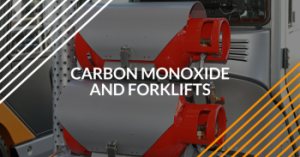Complete Powerpoint slide presentation for forklift instructors. Ready made training course
Carbon Monoxide and Forklift trucks
 This useful article is by Jake Stewart of Toyota Forklifts. I should add that LPG is often seen as "safe" when used on forklift trucks compared to diesel powered engines. Whilst it is certainly true that Carbon Monoxide won't pollute product as much as diesel, it can be fatal to humans.
This useful article is by Jake Stewart of Toyota Forklifts. I should add that LPG is often seen as "safe" when used on forklift trucks compared to diesel powered engines. Whilst it is certainly true that Carbon Monoxide won't pollute product as much as diesel, it can be fatal to humans.
Carbon monoxide (CO) is a colourless, odourless, and toxic gas emitted by gas-powered devices including automobile and forklift internal combustion engines. Due to its colourless and odourless nature, CO is difficult to detect and can have negative effects in different concentrations. As CO is a main output of forklift engines powered by LPG, forklift operators’ exposure to the gas should be limited and monitored.
CO Poisoning and its Effects
In low concentrations CO can cause noted fatigue in healthy people or chest pain in those suffering from heart disease. If your warehouse facility is improperly ventilated, operators can quickly grow fatigued from CO exposure, putting workers at risk of injury and undermining the operation’s productivity.
As concentrations of CO rise, exposed people can experience:
- impaired vision
- reduced brain function
- headaches
- poor coordination
- dizziness
- confusion
- nausea
CO is fatal at high concentrations as it binds to blood cells before they can be oxygenated, depriving the brain of needed oxygen. These negative effects are known as carbon monoxide poisoning. If detected early, carbon monoxide poisoning can be reversed. However, there is still a risk of permanent damage due to the oxygen deprivation associated with the symptoms.
Problem Areas
In order to limit CO exposure and maintain safe working conditions in any facilities it is necessary to combat two common contributors to high CO levels.
- Equipment: Older and out-of-tune IC forklifts can produce increased levels of CO. If you believe that your equipment is contributing to CO exposure for your operators, the forklift in question should be pulled for testing and engine tuning. Newer forklifts meet more stringent environmental requirements and have lower CO output than older models. If CO is an issue it may be time to update your forklift fleet.
- Facilities: Proper ventilation and air exchange are crucial for maintaining a healthy mix of air that meets or exceeds regulations. It can be difficult to maintain this necessary mix during the winter seasons when you close doors and try to limit energy expenses. Maintaining proper ventilation, air exchanges between your warehouse and separated offices, and regular testing and monitoring can help prevent issues from arising.
Regulations and Reporting
In addition to the costs of lost productivity and worker care, carbon monoxide poisoning can prove costly for your business. If an employee is hospitalized due to CO exposure, staff are required to report the incident. Your facility would then fall under a safety audit including air quality samples that could make you subject to possible prosecution by HSE as well as a required compliance plan for quickly rectifying the issue.
Actions
To limit CO exposure and keep your facilities safe for operators’ health and productivity:
- Ensure proper ventilation and air mixing, even in winter months
- Complete regular maintenance and tuning of your forklift fleet
- Forklifts should be tested to ensure their exhaust output is within prescribed averages
- Consider replacing older, outdated LPG models with newer forklifts
- Test air quality regularly to ensure safety
Disclaimer. The legislative information contained on this web site is my interpretation of the law based on many years in the health and safety business. A definitive interpretation can only be given by the courts. I will therefore not be held responsible for any accident/incident/prosecution arising as a consequence of anyone using any information obtained from this web site.